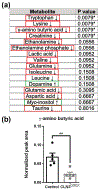Metabolomics-based mass spectrometry methods to analyze the chemical content of 3D organoid models
- PMID: 35660810
- PMCID: PMC9533735
- DOI: 10.1039/d2an00599a
Metabolomics-based mass spectrometry methods to analyze the chemical content of 3D organoid models
Abstract
Metabolomics, the study of metabolites present in biological samples, can provide a global view of sample state as well as insights into biological changes caused by disease or environmental interactions. Mass spectrometry (MS) is commonly used for metabolomics analysis given its high-throughput capabilities, high sensitivity, and capacity to identify multiple compounds in complex samples simultaneously. MS can be coupled to separation methods that can handle small volumes, making it well suited for analyzing the metabolome of organoids, miniaturized three-dimensional aggregates of stem cells that model in vivo organs. Organoids are being used in research efforts to study human disease and development, and in the design of personalized drug treatments. For organoid models to be useful, they need to recapitulate morphological and chemical aspects, such as the metabolome, of the parent tissue. This review highlights the separation- and imaging-based MS-based metabolomics methods that have been used to analyze the chemical contents of organoids. Future perspectives on how MS techniques can be optimized to determine the accuracy of organoid models and expand the field of organoid research are also discussed.
Conflict of interest statement
Conflicts of Interest
There are no conflicts of interest to declare.
Figures





Similar articles
-
Development of high-performance chemical isotope labeling LC-MS for profiling the human fecal metabolome.Anal Chem. 2015 Jan 20;87(2):829-36. doi: 10.1021/ac503619q. Epub 2014 Dec 25. Anal Chem. 2015. PMID: 25486321
-
Challenges in mass spectrometry based targeted metabolomics.Curr Mol Med. 2010 Mar;10(2):216-26. doi: 10.2174/156652410790963312. Curr Mol Med. 2010. PMID: 20196726 Review.
-
Mass spectrometric based approaches in urine metabolomics and biomarker discovery.Mass Spectrom Rev. 2017 Mar;36(2):115-134. doi: 10.1002/mas.21455. Epub 2015 Apr 16. Mass Spectrom Rev. 2017. PMID: 25881008 Review.
-
Capillary Electrophoresis-Mass Spectrometry for Clinical Metabolomics.Adv Clin Chem. 2016;74:1-34. doi: 10.1016/bs.acc.2015.12.002. Epub 2016 Jan 20. Adv Clin Chem. 2016. PMID: 27117659 Review.
-
CE-MS in metabolomics.Electrophoresis. 2009 Jan;30(1):276-91. doi: 10.1002/elps.200800512. Electrophoresis. 2009. PMID: 19107702 Review.
Cited by
-
An Updated Review on Electrochemical Nanobiosensors for Neurotransmitter Detection.Biosensors (Basel). 2023 Sep 19;13(9):892. doi: 10.3390/bios13090892. Biosensors (Basel). 2023. PMID: 37754127 Free PMC article. Review.
-
A scalable organoid model of urothelial aging for metabolic interrogation, infection modeling, and reversal of age-associated changes.bioRxiv [Preprint]. 2025 Jul 3:2025.06.27.662009. doi: 10.1101/2025.06.27.662009. bioRxiv. 2025. PMID: 40631160 Free PMC article. Preprint.
-
Influence of Drying Methods on the Morphological Features, Microstructural Properties, and Antioxidant Performance of Floccularia luteovirens: A Metabolomic Analysis.J Fungi (Basel). 2025 Jan 19;11(1):78. doi: 10.3390/jof11010078. J Fungi (Basel). 2025. PMID: 39852497 Free PMC article.
-
Neurochemical and Morphological Comparisons of Motor Nerve Organoids and Spinal-Cord Explants.ACS Chem Neurosci. 2025 Jan 1;16(1):30-39. doi: 10.1021/acschemneuro.4c00625. Epub 2024 Dec 18. ACS Chem Neurosci. 2025. PMID: 39692746
-
Assessment of cold exposure-induced metabolic changes in mice using untargeted metabolomics.Front Mol Biosci. 2023 Aug 31;10:1228771. doi: 10.3389/fmolb.2023.1228771. eCollection 2023. Front Mol Biosci. 2023. PMID: 37719264 Free PMC article.
References
Publication types
MeSH terms
Grants and funding
LinkOut - more resources
Full Text Sources

